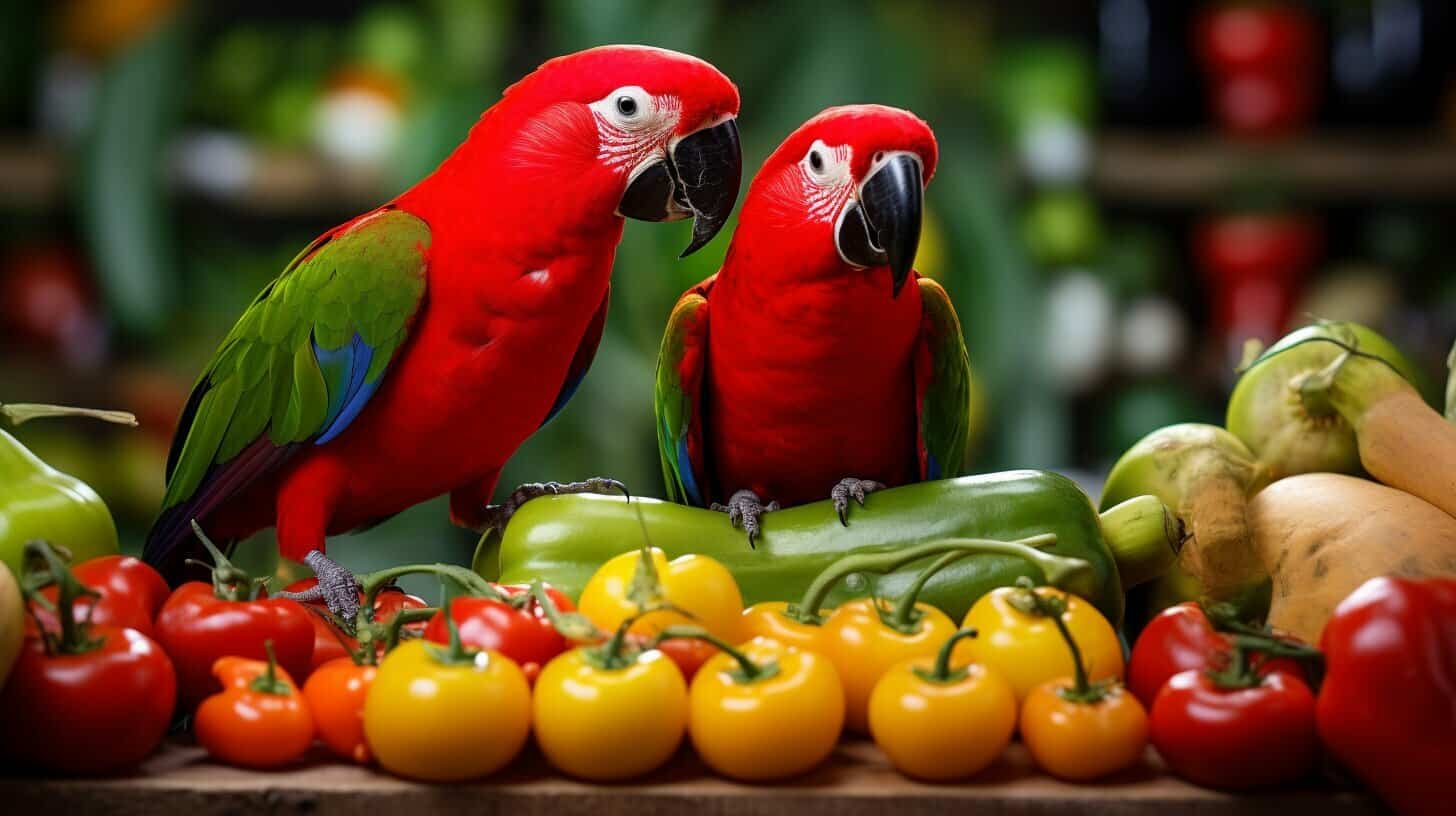As a kakariki owner, you may wonder whether peppers are a safe addition to your bird’s diet. While providing your feathered friend with a varied diet is essential, ensuring that the foods you offer are safe and healthy for them is equally important.
In this guide, we will explore whether kakarikis can eat peppers, the nutritional value of peppers, how to introduce them to your bird’s diet, and potential risks to watch out for.
Can kakarikis eat peppers? Yes, kakarikis can eat peppers. Like many other parrots, Kakarikis can enjoy a range of fresh fruits and vegetables, including peppers. They provide essential nutrients and can be a colourful addition to their diet. Ensuring that any food given is free from pesticides and washed thoroughly is essential. Offering them a varied diet promotes health and well-being.
Key Takeaways:
- Kakarikis can eat peppers as part of their diet, but it’s crucial to introduce them gradually and ensure they are of the non-spicy variety.
- Peppers are rich in various nutrients that can contribute to a healthy diet for these birds.
- Monitoring your kakarikis for any adverse reactions or potential allergic sensitivities to peppers or other foods is important.
Understanding the Dietary Requirements of Kakarikis
Kakarikis are active, social birds that require a balanced diet to maintain their health and well-being. A healthy diet must consist of all the essential nutrients necessary for their body’s proper functioning.
The Kakariki diet consists of fresh fruits, vegetables, nuts, and seeds in their natural form. In addition to a seed mix, providing your Kakariki with fresh fruits and vegetables is critical. Fruits with a high sugar content should be fed in moderation, while vegetables should be offered in unlimited quantities.
Protein is also a crucial nutrient in the Kakariki’s diet. They require protein for maintaining their feathers, growing feathers, and producing eggs. Cooked chicken, boiled eggs, and insects, such as mealworms, can provide your Kakariki with adequate protein.
To maintain good health, Kakarikis require a variety of minerals, including calcium and phosphorus, and vitamins such as Vitamin A and D. Exotic fruits and vegetables, such as peppers, are an excellent source of nutrients for Kakariki.
It is essential to ensure that your Kakariki eats various healthy foods to maintain a balanced diet. A lack of variety in their diet can lead to deficiencies and health problems.
Exploring the Nutritional Value of Peppers
If you’re considering adding peppers to your kakariki’s diet, it’s important to understand their nutritional benefits. Peppers are low in calories and high in essential vitamins and minerals, making them a nutritious addition to your bird’s meals.
| Nutrient | Amount per 100g |
|---|---|
| Vitamin C | 127.7 mg |
| Vitamin A | 375 IU |
| Potassium | 211 mg |
| Folate | 10 mcg |
| Carbohydrates | 6.0 g |
| Fiber | 1.5 g |
| Protein | 1.2 g |
The high levels of vitamin C in peppers can improve your kakariki’s immune system and help fight off infections. Vitamin A is also present in peppers, which is essential for maintaining healthy feathers and skin. Potassium helps regulate fluid balance in the body, while folate is important for cell growth and development.
Peppers also contain antioxidants that can help protect your kakariki’s cells from damage and reduce the risk of chronic diseases. Capsaicin, the compound responsible for the spiciness in some peppers, has been shown to have anti-inflammatory properties and can aid in digestion.
Overall, peppers are a great source of essential vitamins, minerals, and antioxidants that can contribute to a healthy diet for your kakariki.
Are Peppers Safe for Kakarikis?
Safety should always be a top priority when considering adding new foods to your kakarikis’ diet. While peppers can provide valuable nutritional benefits, knowing whether they are safe for kakarikis to consume is important.
Fortunately, peppers are generally considered safe for kakarikis to eat, as long as they are non-spicy and are introduced gradually into their diet. However, there are a few potential risks to be aware of.
| Potential Risks | Description |
|---|---|
| Allergic reactions or sensitivities | Some birds may experience allergic reactions or sensitivities to certain foods, including peppers. Look for signs of respiratory distress, feather plucking, or digestive issues, and consult with a veterinarian if you suspect your bird is having an adverse reaction. |
| Excessive amounts | While peppers can offer numerous nutritional benefits, feeding your kakarikis excessive amounts can lead to digestive upset or other issues. Offer peppers in moderation, and make sure they are balanced with other recommended foods in your bird’s diet. |
| Spicy varieties | Spicy peppers can cause discomfort or even pain for your bird. Stick with non-spicy varieties when offering peppers to your kakarikis, and monitor for any signs of distress. |
Overall, peppers can be a safe and healthy addition to your kakarikis’ diet, but it’s important to be cautious and introduce them gradually. Keep an eye out for any potential adverse reactions or sensitivities, and make sure peppers are balanced with other recommended foods to maintain a healthy diet for your feathered friend.
Introducing Peppers to Kakarikis’ Diet
If you have decided to include peppers in your kakarikis’ diet, it’s essential to introduce them gradually, as with any new food. Start with a small amount of sliced or diced pepper and mix it in with their usual food. Over time, you can gradually increase the amount until it makes up a small portion of their meals.
It’s also crucial to ensure that you are feeding your kakarikis non-spicy peppers, as spicy varieties can harm them. Red, yellow, and green bell peppers are safe choices and rich in beneficial nutrients.
Remember, birds have different preferences and tastes, so don’t be discouraged if your kakarikis is initially hesitant to try peppers. You can try offering them in different ways, such as raw, roasted, or blended into a puree with other fruits and vegetables.
As with any food, monitoring your kakarikis for any adverse reactions after introducing peppers to their diet is important. Allergic reactions or sensitivities can occur, so watch for signs of vomiting, diarrhea, or lethargy. If you suspect your bird has an adverse reaction, contact your veterinarian immediately.
Introducing peppers to your kakarikis’ diet can be a healthy addition, but it’s crucial to do so gradually, choose non-spicy varieties, and monitor for any adverse reactions. Your feathered friend will thank you for providing a varied and nutritious diet.
Benefits of Feeding Peppers to Kakarikis
Adding peppers to your kakarikis’ diet can benefit their health and well-being. Here are some of the advantages of including peppers in their meals:
| Benefit | Explanation |
|---|---|
| Improved digestion | The antioxidants in peppers can help reduce inflammation in your kakarikis’ body, potentially alleviating symptoms of arthritis or other inflammatory conditions. |
| Vibrant feather colouration | The high amounts of vitamin A and other carotenoids found in peppers can contribute to a more vibrant and colourful plumage in your kakarikis. |
| Boosted immune system | The vitamin C in peppers can help to boost your kakarikis’ immune system, providing protection against illnesses and infections. |
| Reduced inflammation | The antioxidants present in peppers can help to reduce inflammation in your kakarikis’ body, potentially alleviating symptoms of arthritis or other inflammatory conditions. |
Remember, while peppers can offer numerous benefits for your kakarikis, they should still be balanced with other recommended foods to ensure a healthy and varied diet.
Kakarikis and Spicy Food: A Cautionary Note
While peppers can offer a range of benefits for your kakarikis, it’s important to be aware of the risks associated with spicy foods. Spicy peppers can cause discomfort and irritation for your bird’s digestive system.
If you decide to introduce peppers to your kakarikis’ diet, make sure to use a non-spicy variety and do so in small quantities. Remember that any new food can take time for your bird to get used to, so be patient and closely monitor your kakariki’s health.
Contact your veterinarian immediately if you notice any signs of discomfort or distress after feeding your kakarikis peppers, such as vomiting, diarrhoea, or a lack of appetite. These could be symptoms of an allergic reaction or a more serious health issue.
Tip: If you’re unsure about whether a specific type of pepper is safe for your kakarikis, consult with your veterinarian or a bird specialist first.
Other Recommended Foods for Kakarikis
Peppers are a great addition to your kakarikis’ diet, but they should be balanced out with other recommended foods to ensure they receive all the necessary nutrients to maintain a healthy lifestyle.
Regarding fruits, you can offer your kakarikis apples, bananas, berries, grapes, and melons. Vegetables like broccoli, carrots, kale, and sweet potato are also excellent choices.
Grains like cooked brown rice and quinoa can also be included in their diet, along with some protein options like boiled eggs and cooked chicken.
It’s important to remember that kakarikis have sensitive digestive systems, so avoid feeding them sugary or salty snacks, dairy products, or processed foods.
By offering various recommended foods, you can ensure that your kakarikis receive a balanced diet that meets all their nutritional needs.
Potential Allergic Reactions or Sensitivities
Even if peppers are generally safe for kakarikis, there is always the possibility of an allergic reaction or sensitivity. Symptoms can vary, including digestive issues such as vomiting or diarrhoea, respiratory problems like coughing or wheezing, or skin irritation and itching.
If you suspect your kakariki may be experiencing an allergic reaction or sensitivity to peppers or any other food, it’s essential to seek veterinary advice immediately. In severe cases, symptoms can escalate quickly and lead to potentially life-threatening situations.
Allergies and sensitivities can develop over time, so carefully monitor your bird’s reactions to any new foods or changes in their diet. If you notice any changes in your kakarikis’ behaviour or health after introducing peppers or any other food, it’s best to err on the side of caution and seek veterinary advice.
Conclusion
As a kakariki owner, it’s natural to want to provide the best possible diet for your feathered friend. While peppers can offer valuable nutritional benefits, approach them carefully and feed them in moderation.
By gradually introducing peppers of the non-spicy variety into your kakariki’s diet, you can ensure they receive the vitamins, minerals, and other components that support their overall health.
Remember that peppers are just one component of a balanced diet for your kakarikis. Make sure to include other recommended foods such as various fruits, vegetables, grains, and protein sources to maintain a healthy and diverse diet. Keep a watchful eye for any signs of allergic reactions or sensitivities, and seek veterinary advice if necessary.
With the right care and attention, you can provide your kakarikis with a healthy and enjoyable diet that supports their well-being for years to come.
FAQ
Q: Can kakarikis eat peppers?
A: Yes, kakarikis can safely consume peppers as part of their diet.
Q: What are the dietary requirements of kakarikis?
A: Kakarikis have specific nutritional needs, including fruits, vegetables, and other essential components.
Q: What is the nutritional value of peppers for kakarikis?
A: Peppers are rich in vitamins, minerals, and other beneficial components that contribute to a healthy diet for kakarikis.
Q: Are peppers safe for kakarikis?
A: Peppers are generally safe for kakarikis, but it’s important to be cautious when introducing new foods.
Q: How can I introduce peppers to my kakarikis’ diet?
A: Introducing peppers gradually and with care is recommended to ensure a smooth transition for your birds.
Q: What are the benefits of feeding peppers to kakarikis?
A: Feeding peppers to kakarikis can improve digestion, enhance feather colouration, and contribute to overall health.
Q: Should I be cautious about feeding kakarikis spicy food?
A: While peppers are generally safe, it’s important to be cautious about introducing spicy varieties or excessive amounts.
Q: What other foods are recommended for kakarikis?
A: Besides peppers, other recommended foods for kakarikis include fruits, vegetables, grains, and protein sources.
Q: Are there potential allergic reactions or sensitivities to watch out for?
A: It’s important to be aware of potential allergic reactions or sensitivities that kakarikis may have to peppers or other foods.
Q: Can kakarikis eat peppers?
A: Yes, kakarikis can eat peppers, but it’s important to introduce them gradually and balance them with other recommended foods.



Have comments or questions about this article? Then get involved!
Spotted an error or something we have missed? Let us know